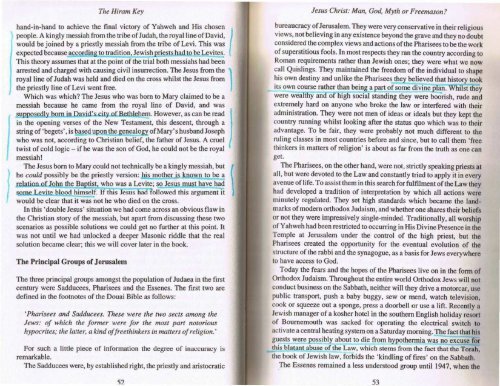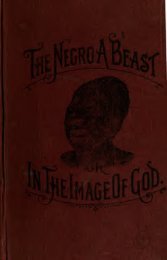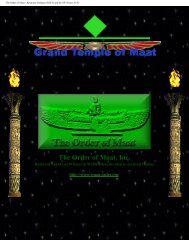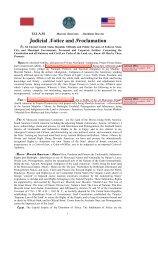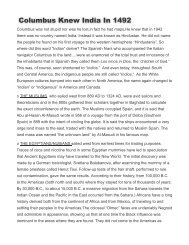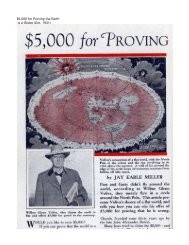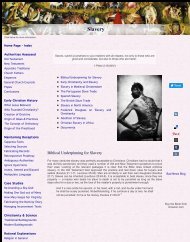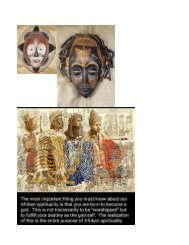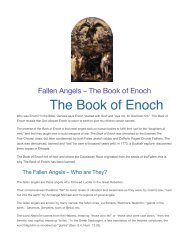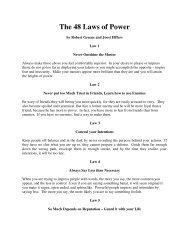The Hiram Key
You also want an ePaper? Increase the reach of your titles
YUMPU automatically turns print PDFs into web optimized ePapers that Google loves.
53<br />
}<br />
<strong>The</strong> <strong>Hiram</strong> <strong>Key</strong><br />
hand-in-hand to achieve the final victory of Yahweh and His chosen<br />
people. A kingly messiah from the tribe of Judah, the royal line ofDavid, /<br />
would bejoined by a priestly messiah from the tribe of Levi. This was<br />
expected because according to tradition, Jewi sh.pri~ t s had to .. be I&vites.<br />
1<br />
This theory assumes that at the point of the trial both messiahs had been<br />
arrested and charged with causing civil insurrection. <strong>The</strong> Jesus from the<br />
royal line of Judah was held and died on the cross whilst the Jesus from<br />
the priestly line of Levi went free.<br />
Which was which? <strong>The</strong> Jesus who was born to Mary claimed to be a<br />
messiah because he came from the royal line of David, and was<br />
,supposedLyj>om in Daxid.:s.cdty ~ etbJ em. However, as can be read<br />
in the opening verses of the New Testament, this descent, through a<br />
string of 'begets', is !lased uQQ.n the genealogx of Mary's husband Joseph<br />
who was not, according to Christian belief, the father of Jesus. A cruel<br />
twi st of cold logic - if he was the son of God, he could not be the royal<br />
messiah!<br />
<strong>The</strong> Jesus born to Mary could not technically be a kingly messiah, but<br />
he could possibly be the priestly version: .his motheusJmocwn to be a<br />
.re.ktiP hn the Ba tist who was a Levite~ so Jesl!!..must havt;" had<br />
.u)lne .Leyj t ~ lod himself. If thi s esus ha ollowed thi s argument it<br />
would be clear that it was not he who died on the cross.<br />
In this 'double Jesus' situation we had come across an obvious flaw in<br />
the Chri sti an story of the messiah, but apart from discussing these two<br />
scenarios as possible solutions we could get no further at this point. It<br />
was not until we had unlocked a deeper Masonic riddle that the real<br />
solution became clear; this we will cover later in the book.<br />
<strong>The</strong> Principal Groups of Jerusalem<br />
<strong>The</strong> three principal groups amongst the population of Judaea in the first<br />
century were Sadducees, Pharisees and the Essenes. <strong>The</strong> first two are<br />
defined in the footnotes of the Douai Bible as follows:<br />
'Pharisees and Sadducees. <strong>The</strong>se were the two sects among the<br />
Jews: of which the former were for the most paT1 notorious<br />
hypocrites; the latter, a kind offreethinkers in matters o/religion.'<br />
For such a little piece of information the degree of ina{;{;uracy is<br />
remarkable.<br />
<strong>The</strong> Sadducees were, by established right, the priestly and aristocratic<br />
Jesus Christ: Man, God, Myth or Freemason?<br />
bureaucracy of Jerusalem. <strong>The</strong>y were very conservative in their religious<br />
views, not believing in any existence beyond the grave and they no doubt<br />
considered the complex views and actions of the Pharisees to be the work<br />
of superstitious fools. In most respects they ran the country according 10<br />
Roman requirements rather than Jewish ones; they were what we now<br />
call Quislings. <strong>The</strong>y maintained the freedom of the individual to shape<br />
his own destiny and unlike the Pharisees they believed that history took<br />
its own course rathe! than being a part of some divine Ian. I st they<br />
were wealthy and of high social standing they were boori sh, rude and<br />
extremely hard on anyone who broke the Jawor interfered with their<br />
administration. <strong>The</strong>y were not men of ideas or ideals but they kepI the<br />
country running whilst looking after the status quo which was to their<br />
advantage. To be fair. they were probably not much different to the<br />
rul ing classes in most countries before and si nce. but to call them 'free<br />
thinkers in matters of religion' is about as far from the truth as one can<br />
get.<br />
<strong>The</strong> Pharisees, on the other hand, were not, snictly speaking priests at<br />
all. but were devoted to the Law and constantly tried to apply it in every<br />
avenue ofJife. To assist them in this search for fu]filment of the Law they<br />
had developed a tradition of interpretation by which all actions were<br />
minutely regulated. <strong>The</strong>y set high standards which became the landmarks<br />
of modern orthodox Judaism, and whether one shares their beliefs<br />
or not they were impressively single-minded. Traditionally, all worship<br />
of Yahweh had been restricted to occurring in His Divine Presence in the<br />
Temple at Jerusalem under the control of the high priest, but the<br />
Pharisees created (he opportunity for the eventual evolution of the<br />
structure of the rabbi and the sy nagogue, as a basis for Jews everywhere<br />
to have access to God.<br />
Today the fears and the hopes of the Pharisees live on in the form of<br />
Orthodox Judaism. Throughout the entire world Orthodox Jews will not<br />
conduct business on the Sabbath, neither will they drive a motorcar, use<br />
public transport. push a baby buggy, sew or mend, watch television,<br />
cook or squeeze out a sponge, press a doorbell or use a lift. Recently a<br />
Jewish manager of a kosher hotel in the southern English holiday reson<br />
of Boumemouth was sacked for operating the electrical switch to<br />
activate acentraJ heating system on a Saturday morning. <strong>The</strong> fact that his<br />
guests were QOssi bly about to die from hypothermia was no excuse (or<br />
this blatant abuse of the Law, which stems from the fact that the Torah.<br />
the book of Jewish law, forbids the 'kindling of fires' on the Sabbath.<br />
<strong>The</strong> Essenes remained a less understood group until 1947, when the


